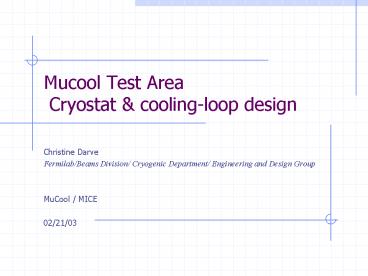Mucool Test Area Cryostat PowerPoint PPT Presentation
Title: Mucool Test Area Cryostat
1
Mucool Test Area Cryostat cooling-loop design
- Christine Darve
- Fermilab/Beams Division/ Cryogenic Department/
Engineering and Design Group - MuCool / MICE
- 02/21/03
2
MuCool MICE
MuCool Test Area
3
Cryostat design
4
Specifications
The Linac beam will deposit within the absorber a
maximum heat deposition of 150 Watt P
1.2 atm, T 17 K Dr lt 5 DT 1 K (could be 3 K)
- Safety gudelines
- Guidelines for the Design, Fabrication,
Testing, Installation and Operation of LH2
Targets20 May 1997, Fermilab by Del Allspach et
al. - Fermilab ESH (5032)
- code/standard ASME, NASA
- NEC (art 500)
- CGA
5
Materials
- Caltech LH2 pump
- Max LH2 mass-flow 450 g/s (0.12 MPa, Tin17 K)
- DP total lt 0.36 psig
- References
- A high power liquid hydrogen target for parity
violation experiments, E.J. Beise et al.,
Research instruments methods in physics
research (1996), 383-391 - MuCool LH2 pump test report, C. Darve and B.
Norris, (09/02)
- Lab-G magnet
6
Conceptual Design
7
Heat load calculations
Magnet _at_ 300 K
Cryostat vacuum vessel _at_ 300 K
1.5 W (39 W if no MLI)
67 W
N2
Cryostat Thermal shield _at_ 80 K
Cooling line
6 W
0.2 W
17 W
Absorber _at_ 20 K
Cryostat windows
0.3 W
He
General refrigeration system
48 W
Safety factor 2
CD, 12/07/01
8
Materials list - Cryostat Design
The MTA cryostat is mainly composed of
- LH2 Absorber
- Vacuum vessel
- Thermal shield
- Hydrogen buffer
- Vacuum window
- Transfer lines
- Safety devices
- Heat exchanger
- LH2 pump
- Motor
- Supports
- Equipment
Cryogens used
- LN2 to cool Thermal shield
- Ghe to cool LH2 cryo-system
- LH2 to cool cryo-system (beamstatic)
9
Assembly
- Vacuum vessel MAWP25 psig
- SS, 16 IPS Sch10, 48 IPS Sch10
- Dome (SS, 0.25 inch)
- Plate (SS, 0.25 inch)
- Central support (1 inch)
- Thermal shield (Al) MLI (Al, Mylar)
- Aluminum braids
- Aluminum cooling line
- He, H2 and N2 Piping (SS, 1-2 inch IPS)
- Hydrogen buffer(SS,f 3 inch)
- Vacuum window Flange, Al, SS, Al seal
- Vacuum pump flange
- Relief vacuum
10
Pressure safety devices
- Pressure relief valve LH2 II C 4 a (iii)
- Relief pressure (10 psig or 25 psid)
- Sized for max. heat flux produced by air
condensed on the LH2 loop at 1 atm. - 2 valves ACGO gt 0.502 inch2
- ASME code Redundant
- Capacity 52 g/s
- Pressure relief valve Insulation vacuum II D
3 - MAWP (15 psig internal)
- Capable of limiting the internal pressure in
vacuum vessel to less than 15 psig following the
absorber rupture (deposition of 25 liter in the
vacuum space) - Vapor evaluation q 20 W/cm2
- Take into account DP connection piping and
entrance/exit losses - 3 parallel plates (FNAL design) gt 2 inch
- Calculated Capacity 197 g/s Redundant
- Relief system must be flow tested
11
MTA Cryostat Design
- Heat exchanger assembly
- Coil (copper, f 0.55 inch)
- Outer shell (SS, 6 inch tube)
- LH2 pump assembly
- LH2 pump and shaft with foam
- Motor outer shield
- Absorber assembly
- Black/Wing windows and manifold design
- Interface of the systems
- Bimetallic junction
- Indium Doubled-seal
- Supports
- G10 spider and rods
12
MTA Cryostat Design
- Equipment
- Pressure transducers
- Temperature sensors
- Flowmeter
- Heater
- Valves and actuators
- Vacuum pump cart
- Other instrumentation
- Safety constraints
- N2 guard
- Low excitation current
- Interlocks
- Minimum spark energies for ignition of H2 in air
is 0.017 mJ at 1 atm, 300 K - Lower pressure for ignition is 1 psia (min abs.
0.02 psia // 1.4 mbar)
13
Comments/questions
- Cryo-pumping
- Position of cryostat vacuum windows
- Interfaces atmosphere or vacuum behind cryostat
vacuum windows - Absorber Instrumentation routing and ports
14
MTA Cryostat design Conclusions
- Cryostat 3D model current focuses
- Change orientation of the heat exchanger
- Final LN2 cooling system
- Implementation of vacuum windows
- Heater implementation
- Supports
- Instrumentation implementation
15
As it looks today
16
Cooling-loop design (Introduction to Oxford
analysis)
17
Cooling-loop Design
mass flow
Velocity at nozzle
Given geometry, Power and nozzle distribution
DP
Heat transfer coeff.
DT
Flow Simulation by Wing Lau/ Stephanie Yang
(Oxford)
- Simulate MTA manifold geometry
- Simulate beam at 150 W (vol. deposition, ø10mm, 3
sigma gaussian) - Calculate heat transfer coefficients and
temperature distribution for MTA conditions (DV
0.5 m/s 4 m/s)
18
Pressure drop calculations
Study of the thermo-hydraulic behavior in LH2
absorber w/ DT1 K
Will a velocity at the nozzle lower than 2 m/s be
enough for ionization cooling (i.e. DTlt 1K)?
5.3
17.5
13.2
Nozzle supply velocity 3 m/s Maximum allowable
DP 0.364 psi Total DP calculated 0.301 psi
5.3
15.1
38.3
19
Temperature distribution simulation By Wing Lau
and Stephanie Yang (Oxford)
20
Temperature distribution simulation By Wing Lau
and Stephanie Yang (Oxford)
DTlt 1 K
But DP 90 psi (DP adm.76psi)
21
Temperature distribution simulation By Wing Lau
and Stephanie Yang (Oxford)
DTlt 1 K
Model A
Lower limit for the solution with m_dot 38 g/s
22
Temperature distribution simulation By Wing Lau
and Stephanie Yang (Oxford)
23
Temperature distribution simulation By Wing Lau
and Stephanie Yang (Oxford)
DTlt 1 K
But DP 0.101 psi (DP adm.0.119 psi)
24
MTA cooling loop system Conclusions
- Cooling loop Focuses
- The Model A proves that DT1K is achieved if
nozzle velocity is 0.5 m/s - Therefore any configuration with at least 26
nozzles, larger then 0.43 inch diameter will meet
our requirement. - Model C will permit us to cross-check the current
solution.
Proposed Solution 11 supply/15 return, Dia 0.6
25
Process Instrumentation Diagram

